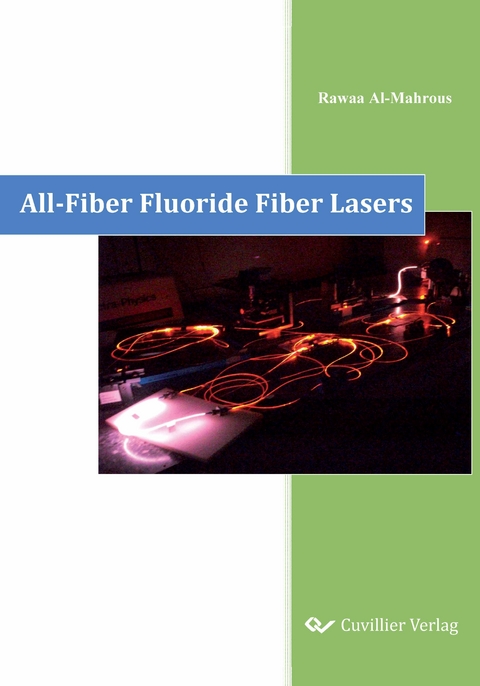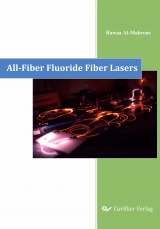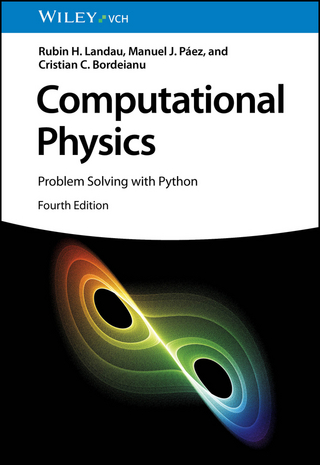All-Fiber Fluoride Fiber Lasers
Seiten
2012
|
1., Aufl.
Cuvillier, E (Verlag)
978-3-95404-255-5 (ISBN)
Cuvillier, E (Verlag)
978-3-95404-255-5 (ISBN)
- Titel ist leider vergriffen;
keine Neuauflage - Artikel merken
The goal of this work was to develop and optimize fiber lasers in the visible range, based on Pr3+/Yb3+-doped fluoride fibers, which delivered their output power in a fiber. Some of the fiber laser setups did not contain any optical free-space device. So time and effort could be spared to adjust these optical devices. Furthermore, using a diode laser instead of the Titanium-Sapphire laser allowed to place all these laser setups in a small box.
In the beginning a short overview on the important laser transitions was given, as well as lifetime measurements of the important energy level 1G4 of praseodymium. Thereafter, I tried to treat the problem to connect fluoride with silica fibers by using a new thermal splicing method. It was shown that low-loss thermal splices are possible. Due to experimental limitations the splice quality was not very reproducible. Therefore, a glue splicing method was developed and found to be more stable and flexible. Moreover, the glue splice with index matching gel was found to be easier to fabricate, but less resistant to high optical power.
The glue and thermal splices were employed in a simple fiber laser setup. Different fluoride fibers lengths were compared, as well as different loop mirror reflectivities to obtain maximum output power for the red laser, which was more than 10 mW. About 22 mW was achieved in a linear laser configuration using FC/PC connectors between silica and fluoride fibers. A ring laser was also presented and improved by using an additional mirror, which was replaced later by a loop mirror. In total, the maximum laser output power was increased to more than 20 mW, and the smallest laser threshold decreased to less than 35 mW.
The tunable fiber laser played a significant role in our research, because it can be used in medicine for example by cytology, the study of the properties of single cells. The red and orange spectrum was covered using a 40 cm long Pr3+/Yb3+-doped ZBLAN fiber. To increase the output power, two active fibers were inserted in one tunable fiber laser setup. The resulting output power was 18 and 9 mW for the red and the orange laser, respectively. Moreover, the setup contained no optical free-space devices except of the grating block.
In the beginning a short overview on the important laser transitions was given, as well as lifetime measurements of the important energy level 1G4 of praseodymium. Thereafter, I tried to treat the problem to connect fluoride with silica fibers by using a new thermal splicing method. It was shown that low-loss thermal splices are possible. Due to experimental limitations the splice quality was not very reproducible. Therefore, a glue splicing method was developed and found to be more stable and flexible. Moreover, the glue splice with index matching gel was found to be easier to fabricate, but less resistant to high optical power.
The glue and thermal splices were employed in a simple fiber laser setup. Different fluoride fibers lengths were compared, as well as different loop mirror reflectivities to obtain maximum output power for the red laser, which was more than 10 mW. About 22 mW was achieved in a linear laser configuration using FC/PC connectors between silica and fluoride fibers. A ring laser was also presented and improved by using an additional mirror, which was replaced later by a loop mirror. In total, the maximum laser output power was increased to more than 20 mW, and the smallest laser threshold decreased to less than 35 mW.
The tunable fiber laser played a significant role in our research, because it can be used in medicine for example by cytology, the study of the properties of single cells. The red and orange spectrum was covered using a 40 cm long Pr3+/Yb3+-doped ZBLAN fiber. To increase the output power, two active fibers were inserted in one tunable fiber laser setup. The resulting output power was 18 and 9 mW for the red and the orange laser, respectively. Moreover, the setup contained no optical free-space devices except of the grating block.
| Sprache | englisch |
|---|---|
| Einbandart | kartoniert |
| Themenwelt | Naturwissenschaften ► Physik / Astronomie |
| Schlagworte | fiber laser • Glue splicing technique • Nachrichten- und Kommunikationstechnik • Physik der kondensierten Materie (einschließlich Festkörperphysik, Optik) • Praseodymium-ytterbium-doped fibers • Red and orange fiber laser • ring fiber laser • Thermal splicing technique • Tunable fiber laser • Up-conversion |
| ISBN-10 | 3-95404-255-X / 395404255X |
| ISBN-13 | 978-3-95404-255-5 / 9783954042555 |
| Zustand | Neuware |
| Haben Sie eine Frage zum Produkt? |
Mehr entdecken
aus dem Bereich
aus dem Bereich
von den Werkzeugen über Methoden zum TQM
Buch | Softcover (2024)
Springer Fachmedien (Verlag)
32,99 €
Problem Solving with Python
Buch | Softcover (2024)
Wiley-VCH (Verlag)
109,00 €




